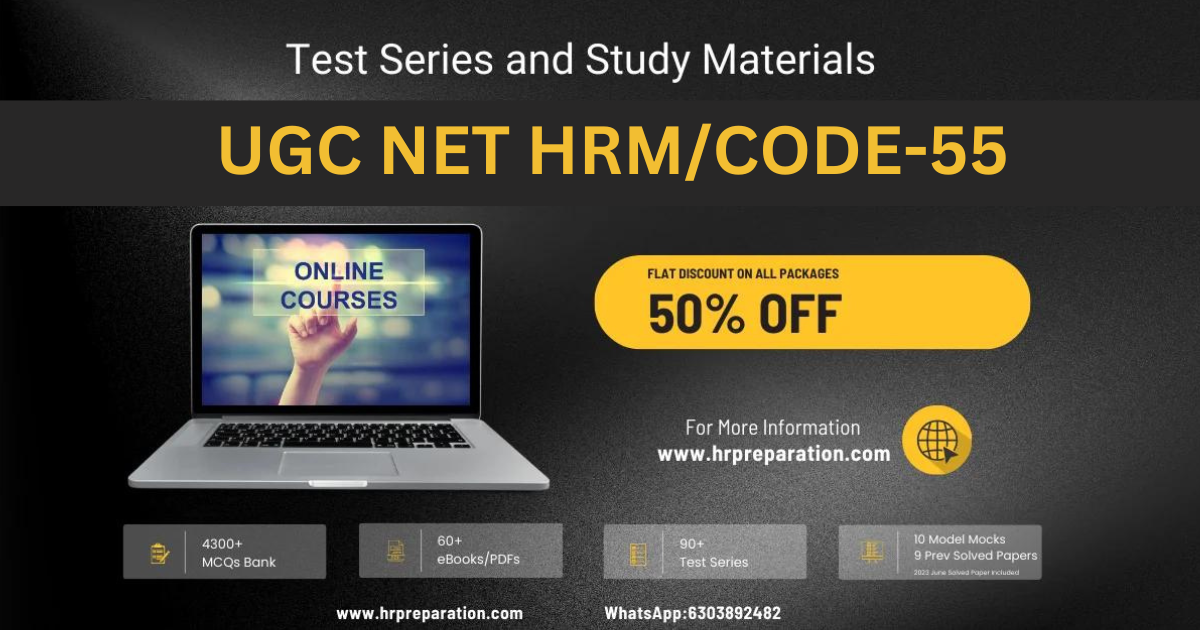NET HRM SYLLABUS AND EXAM PATTERN 2025
UGC-NET June 2025 shall be conducted by the NTA. The
University Grants Commission (UGC) has entrusted the responsibility of
conducting UGCNET to the NTA. UGC-NET is a test being conducted to determine
the eligibility ‘for Assistant Professor’ and ‘for Junior Research Fellowship
and Assistant Professor’ in Indian universities and colleges.
Mode of Examination: The Examination shall be conducted as a Computer Based Test (CBT) only. Wherever Online Examination has been used
elsewhere in this booklet, it means CBT.
Pattern: The Test will consist of two papers. Both papers will consist of objective-type questions. There will be no break between
papers.
Exam Pattern:
This exam consists of 150 Questions from Papar-1&2 and all questions are in MCQs only.
We provided a Preparation Strategy to crack UGC NET HRM Exam and if you are looking for Online coaching for UGC NET HRM then you are at the right place. Please check out our Online Course for UGC NET HRM.
Paper-1:
Number of Questions-50MCQs
Marks-100 Marks(Each Question carries 2marks)
The questions will be generic in nature, intending to assess the teaching/ research aptitude of the candidate. It will primarily be designed to test reasoning ability, comprehension, divergent thinking and general awareness of the candidate.
Paper-2:
Number of Questions-100MCQs
Marks-100 Marks(Each Question carries 2marks)
Above questions are from HRM, Industrial Relations, Labour
Laws, Labour Legislations, Labour Market with 10 Units and 14 Labour Acts.
The time is 3hr given for exam without break.
Unit - I
Principles and Practices of
Management:
Development of management
Thought, Contributions of Taylor, Fayol, Mayo, Mary Parker Follett and C.I.
Barnard. Behavioural Approach, Systems Approach, Quantitative Approach and
Contingency Approach.
Function of Management:
Planning and Decision Making,
Organising, Staffing, Directing, Controlling, Coordinating.
Unit – II
Human Resource Management:
Conceptual framework, Human
Resource Planning, Job Analysis, Recruitment, Selection, Placement, Induction,
Training and Development, Performance Management, Job Evaluation, Compensation
Management, Employee Benefits and Incentives, Managing Career.
New Trends in HRM:
The changing environment of HRM and
contemporary challenges, Emerging HRM Concepts.
Unit – III
Human Resource Development (HRD):
Concepts, Assumptions, Values,
HRD Mechanisms, Action – research Model, HRD Culture and Climate, HRD
Interventions, HR Accounting and Audit, Consultant – client relationship,
Knowledge Management, Human Resource Information System.
International Human Resource
Management (IHRM):
Organisational context of IHRM,
IHRM and Sustainable Business, Functions of IHRM, Cross–Cultural Studies,
Cultural Diversity, Transnational Organisations, IHRM models.
Unit – IV
Organisational Behaviour:
Concept, Scope, Nature of Human Behaviour, Personality, Perception, Learning, Attitude, Motivation,
Interpersonal Behaviour, Group Dynamics, Leadership, Communication, Power and
Authority, Stress, Organisational Change and Development.
Unit – V
Industrial Relations:
Concept, Scope, Evolution,
Approaches, Actors and Models, Conflict and cooperation, Bi-patriotism,
Tri-partitism, Collective Bargaining, Workers’ Participation in Management,
Grievance Handling and Disciplinary Action, Code of Conduct, Industrial
Relations in changing scenario, Employers’ organisations.
Trade Unions:
Concepts, Evolution, Problems of
trade unions in India, Recognition, The Trade Unions Act, 1926. Emerging role
of trade unions in India.
Unit – VI
Industrial Disputes:
Factors, Forms, Trends,
Prevention and Settlement, Role of State and Central Labour Administration,
Strikes and Lockouts. The Industrial Employment (Standing Orders) Act, 1946.
The Industrial Disputes Act, 1947.
Unit – VII
Labour Legislation:
Objectives, Principles,
Classification and Evolution. International Labour Organisation, Social Justice
and Labour Legislation, Indian Constitution and Labour Laws.
·
The Factories Act, 1948.
·
The Mines Act, 1952.
· The Interstate Migrant Workmen (Regulation of employment and conditions of service) Act, 1979.
· The
Contract Labour (Regulation and Abolition) Act, 1970.
·
The Building and other Construction Workers (Regulation of employment and
conditions of service) Act, 1996.
·
The Child Labour (Prohibition and Regulation) Act, 1986.
Unit – VIII
Wages:
Concept, Types, Factors
influencing wages, Wage Theories and Wage Differentials
·
The Minimum Wages Act, 1948.
·
The Payment of Wages Act, 1936.
·
The Payment of Bonus Act, 1965.
·
The Equal Remuneration Act, 1976.
·
The Payment of Gratuity Act, 1972.
·
The Employees’ Provident Fund and Miscellaneous Provisions Act, 1952
Unit – IX
Labour Welfare:
Concept, Scope, Types, Theories
and Principles, Industrial Health and Hygiene, Industrial Accidents and safety,
Occupational Diseases
Social Security:
Concept and Scope, Social
Assistance and Social assurance.
Unit – X
Labour Market:
Features, Demand and Supply of Labour, Nature and Composition of Indian Labour Force, Unemployment and Underemployment, Types of Labour Market, Characteristics of Indian Labour Market, New Dynamics of Labour Market in India, Economic Systems and Labor Market, Problems of Labour in India.

- UGC NET HRM LABOUR WELFARE SYLLABUS Click Here
- UGC NET PAPER-1 SYLLABUS Click Here